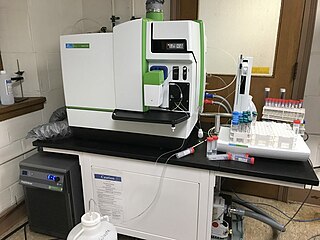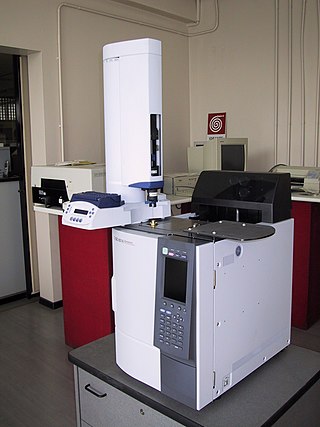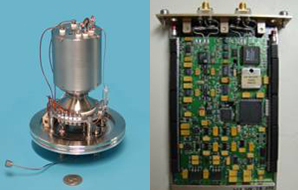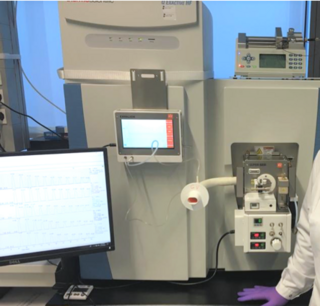
Inductively coupled plasma mass spectrometry (ICP-MS) is a type of mass spectrometry that uses an inductively coupled plasma to ionize the sample. It atomizes the sample and creates atomic and small polyatomic ions, which are then detected. It is known and used for its ability to detect metals and several non-metals in liquid samples at very low concentrations. It can detect different isotopes of the same element, which makes it a versatile tool in isotopic labeling.

A smoke detector is a device that senses smoke, typically as an indicator of fire. Smoke detectors/Alarms are usually housed in plastic enclosures, typically shaped like a disk about 125 millimetres (5 in) in diameter and 25 millimetres (1 in) thick, but shape and size vary. Smoke can be detected either optically (photoelectric) or by physical process (ionization). Detectors may use one or both sensing methods. Sensitive alarms can be used to detect and deter smoking in banned areas. Smoke detectors in large commercial and industrial buildings are usually connected to a central fire alarm system.

Gas chromatography (GC) is a common type of chromatography used in analytical chemistry for separating and analyzing compounds that can be vaporized without decomposition. Typical uses of GC include testing the purity of a particular substance, or separating the different components of a mixture. In preparative chromatography, GC can be used to prepare pure compounds from a mixture.

Gas chromatography–mass spectrometry (GC–MS) is an analytical method that combines the features of gas-chromatography and mass spectrometry to identify different substances within a test sample. Applications of GC–MS include drug detection, fire investigation, environmental analysis, explosives investigation, food and flavor analysis, and identification of unknown samples, including that of material samples obtained from planet Mars during probe missions as early as the 1970s. GC–MS can also be used in airport security to detect substances in luggage or on human beings. Additionally, it can identify trace elements in materials that were previously thought to have disintegrated beyond identification. Like liquid chromatography–mass spectrometry, it allows analysis and detection even of tiny amounts of a substance.
Photoacoustic spectroscopy is the measurement of the effect of absorbed electromagnetic energy on matter by means of acoustic detection. The discovery of the photoacoustic effect dates to 1880 when Alexander Graham Bell showed that thin discs emitted sound when exposed to a beam of sunlight that was rapidly interrupted with a rotating slotted disk. The absorbed energy from the light causes local heating, generating a thermal expansion which creates a pressure wave or sound. Later Bell showed that materials exposed to the non-visible portions of the solar spectrum can also produce sounds.

An electron capture detector (ECD) is a device for detecting atoms and molecules in a gas through the attachment of electrons via electron capture ionization. The device was invented in 1957 by James Lovelock and is used in gas chromatography to detect trace amounts of chemical compounds in a sample.

Ion mobility spectrometry (IMS) It is a method of conducting analytical research that separates and identifies ionized molecules present in the gas phase based on the mobility of the molecules in a carrier buffer gas. Even though it is used extensively for military or security objectives, such as detecting drugs and explosives, the technology also has many applications in laboratory analysis, including studying small and big biomolecules. IMS instruments are extremely sensitive stand-alone devices, but are often coupled with mass spectrometry, gas chromatography or high-performance liquid chromatography in order to achieve a multi-dimensional separation. They come in various sizes, ranging from a few millimetres to several metres depending on the specific application, and are capable of operating under a broad range of conditions. IMS instruments such as microscale high-field asymmetric-waveform ion mobility spectrometry can be palm-portable for use in a range of applications including volatile organic compound (VOC) monitoring, biological sample analysis, medical diagnosis and food quality monitoring. Systems operated at higher pressure are often accompanied by elevated temperature, while lower pressure systems (1–20 hPa) do not require heating.

Neutron detection is the effective detection of neutrons entering a well-positioned detector. There are two key aspects to effective neutron detection: hardware and software. Detection hardware refers to the kind of neutron detector used and to the electronics used in the detection setup. Further, the hardware setup also defines key experimental parameters, such as source-detector distance, solid angle and detector shielding. Detection software consists of analysis tools that perform tasks such as graphical analysis to measure the number and energies of neutrons striking the detector.

Explosive detection is a non-destructive inspection process to determine whether a container contains explosive material. Explosive detection is commonly used at airports, ports and for border control.
Explosives trace detectors (ETD) are explosive detection equipment able to detect explosives of small magnitude. The detection is accomplished by sampling non-visible "trace" amounts of particulates. Devices similar to ETDs are also used to detect narcotics. The equipment is used mainly in airports and other vulnerable areas considered susceptible to acts of unlawful interference.
A particle counter is used for monitoring and diagnosing particle contamination within specific clean media, including air, water, and chemicals. Particle counters are used to support clean manufacturing practices in a variety of industrial applications. Clean manufacturing is required for the production of many electronic components and assemblies, pharmaceutical drug products and medical devices, and industrial technologies such as oil and gas.
A photoionization detector or PID is a type of gas detector.

The Fido explosives detector is a battery-powered, handheld sensory device that uses amplifying fluorescent polymer (AFP) materials to detect trace levels of high explosives like trinitrotoluene (TNT). It was developed by Nomadics, a subsidiary of ICX Technologies, in the early 2000s as part of the Defense Advanced Research Projects Agency's (DARPA) Dog's Nose program. The Fido explosives detector is considered the first artificial nose capable of detecting landmines in the real world. The device was named after its ability to detect explosive vapors at concentrations of parts per quadrillion, which is comparable to the sensitivity of a bomb-sniffing dog’s nose, i.e. the historical “gold standard” for finding concealed explosives.

Autonomous Detection Systems (ADS), also called biohazard detection systems or autonomous pathogen detection systems, are designed to monitor air or water in an environment and to detect the presence of airborne or waterborne chemicals, toxins, pathogens, or other biological agents capable of causing human illness or death. These systems monitor air or water continuously and send real-time alerts to appropriate authorities in the event of an act of bioterrorism or biological warfare.
A gas detector is a device that detects the presence of gases in an area, often as part of a safety system. A gas detector can sound an alarm to operators in the area where the leak is occurring, giving them the opportunity to leave. This type of device is important because there are many gases that can be harmful to organic life, such as humans or animals.
Materials MASINT is one of the six major disciplines generally accepted to make up the field of Measurement and Signature Intelligence (MASINT), with due regard that the MASINT subdisciplines may overlap, and MASINT, in turn, is complementary to more traditional intelligence collection and analysis disciplines such as SIGINT and IMINT. MASINT encompasses intelligence gathering activities that bring together disparate elements that do not fit within the definitions of Signals Intelligence (SIGINT), Imagery Intelligence (IMINT), or Human Intelligence (HUMINT).

A miniature mass spectrometer (MMS) is a type of mass spectrometer (MS) which has small size and weight and can be understood as a portable or handheld device. What it means to be portable and a set of criteria by which portable and miniature mass spectrometers can be assessed have been discussed in detail. Current lab-scale mass spectrometers however, usually weigh hundreds of pounds and can cost on the range from thousands to millions of dollars. One purpose of producing MMS is for in situ analysis. This in situ analysis can lead to much simpler mass spectrometer operation such that non-technical personnel like physicians at the bedside, firefighters in a burning factory, food safety inspectors in a warehouse, or airport security at airport checkpoints, etc. can analyze samples themselves saving the time, effort, and cost of having the sample run by a trained MS technician offsite. Although, reducing the size of MS can lead to a poorer performance of the instrument versus current analytical laboratory standards, MMS is designed to maintain sufficient resolutions, detection limits, accuracy, and especially the capability of automatic operation. These features are necessary for the specific in-situ applications of MMS mentioned above.

Secondary electro-spray ionization (SESI) is an ambient ionization technique for the analysis of trace concentrations of vapors, where a nano-electrospray produces charging agents that collide with the analyte molecules directly in gas-phase. In the subsequent reaction, the charge is transferred and vapors get ionized, most molecules get protonated and deprotonated. SESI works in combination with mass spectrometry or ion-mobility spectrometry.
Workplace exposure monitoring is the monitoring of substances in a workplace that are chemical or biological hazards. It is performed in the context of workplace exposure assessment and risk assessment. Exposure monitoring analyzes hazardous substances in the air or on surfaces of a workplace, and is complementary to biomonitoring, which instead analyzes toxicants or their effects within workers.

Lorne Elias is a Canadian chemist, inventor, and a pioneer in explosives detection technology. He invented the explosives vapour detector, EVD-1, a portable bomb detection instrument deployed at international airports in Canada in the 1980s. He contributed to the field of explosives detection for over three decades, and is called the father of vapour and trace explosives detection technology.













